
Morphology
Scope & Guideline
Advancing the Frontiers of Linguistic Structure
Introduction
Aims and Scopes
- Geomorphological Processes and Landforms:
The journal explores the dynamics of landforms and their evolution through various geomorphological processes, including erosion, sedimentation, and tectonic activities. - Sediment Transport and Dynamics:
Research on sediment transport mechanisms, sediment budgets, and the impacts of sediment dynamics on landform evolution is a core focus area, emphasizing both natural and anthropogenic influences. - Climate Change and Environmental Impact:
The journal addresses the implications of climate change on geomorphic processes and landforms, investigating historical and modern responses of landscapes to climatic variations. - Remote Sensing and GIS Applications:
Utilization of remote sensing technologies and Geographic Information Systems (GIS) for mapping, analyzing, and modeling geomorphological features is a significant methodological approach in the journal. - Human Impact on Geomorphology:
The journal includes studies on the effects of human activities, such as urbanization and land use changes, on geomorphic processes and landscape evolution. - Innovative Methodologies:
Development and application of new methodologies for analyzing geomorphic features, including machine learning and advanced photogrammetry techniques, are highlighted.
Trending and Emerging
- Impact of Climate Change on Geomorphology:
There is a growing focus on how climate change influences geomorphic processes, with studies exploring the interactions between climatic variations and landscape responses. - Use of Advanced Remote Sensing Technologies:
The integration of remote sensing and UAV technologies for detailed geomorphological mapping and monitoring is trending, allowing for high-resolution analysis of landscape changes. - Biogeomorphology and Ecosystem Interactions:
Research exploring the interactions between biological processes and geomorphology is on the rise, emphasizing how vegetation influences sediment dynamics and landscape stability. - Machine Learning in Geomorphic Analysis:
The application of machine learning techniques for analyzing geomorphic data and predicting sediment transport dynamics is emerging as a significant trend. - Urban Geomorphology and Human Impact Studies:
There is an increasing interest in understanding the geomorphological impacts of urbanization and land use changes, reflecting the interplay between human activities and natural processes.
Declining or Waning
- Traditional Geomorphological Mapping Techniques:
As innovative methodologies such as remote sensing and machine learning gain traction, traditional geomorphological mapping techniques have become less frequently discussed in recent publications. - Static Models of Landscape Evolution:
Research that relies on static models of geomorphological processes is waning, with a shift towards more dynamic and integrated modeling approaches that account for temporal changes. - Descriptive Studies without Quantitative Analysis:
There is a noticeable decline in purely descriptive studies that do not incorporate quantitative analysis or modeling, as the field moves towards evidence-based and data-driven research.
Similar Journals
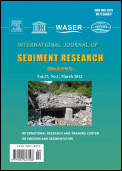
International Journal of Sediment Research
Elevating Understanding of Earth's Sedimentary SystemsThe International Journal of Sediment Research, published by KEAI PUBLISHING LTD, stands as a premier platform for advanced studies in the fields of geology and stratigraphy. With an impressive Q1 ranking in both categories in 2023, this journal hosts a wealth of research that has significantly contributed to our understanding of sediment dynamics and geological processes since its inception in 1981. The journal is dedicated to publishing high-quality research articles, reviews, and case studies that span a broad range of topics, including sedimentology, stratigraphic analysis, and environmental geology. Researchers, professionals, and students will find invaluable insights within its pages, courtesy of cutting-edge methodologies and rigorous peer-review standards. Despite its non-open access status, the journal ensures a global reach, facilitating knowledge sharing and collaboration among academia and industry. With a rich history and a forward-looking approach to scientific exploration, the International Journal of Sediment Research remains a vital resource for those committed to advancing our understanding of Earth's sedimentary systems.
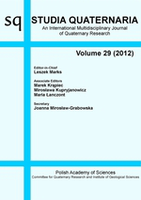
Studia Quaternaria
Advancing knowledge of Earth's dynamic processes.Studia Quaternaria is a leading academic journal published by the Polish Academy of Sciences, Institute of Geological Sciences, specializing in the dynamic fields of Earth-Surface Processes and Geology. With an ISSN of 1641-5558 and an E-ISSN of 2300-0384, this journal has been a prominent platform for scholarly discourse since its inception in 2000. Operating under the open-access model, it aims to disseminate high-quality research that is accessible to a global audience. Studia Quaternaria holds a Q3 ranking in both relevant quartiles as of 2023, indicating its commitment to advancing knowledge in its disciplines despite centering in competitive academic environments. With its publications indexed in Scopus, the journal remains a valuable resource for researchers, professionals, and students looking to stay abreast of innovations and discoveries in Earth-Surface Processes and Geology. Encompassing a broad scope of studies, the journal represents an essential contribution to the geological sciences, fostering a deeper understanding of our planet's changes and processes.
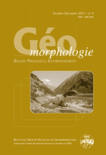
Geomorphologie-Relief Processus Environnement
Pioneering Studies in Earth-Surface ProcessesGeomorphologie-Relief Processus Environnement is a pivotal journal in the field of Earth-Surface Processes, published by the GROUPE FRANCIAS GEOMORPHOLOGIE in France. With an ISSN of 1266-5304 and E-ISSN 1957-777X, the journal has established a notable presence since its inception in 1995. Though it operates without Open Access, it remains an essential resource, particularly in the niche area of geomorphology where it offers valuable insights into the interactions between relief features and environmental processes. The journal achieved a Q3 ranking in 2023 among Earth-Surface Processes, attesting to its significance in advancing research and discussions within this discipline, while it ranks #113/179 in Scopus, placing it in the 37th percentile. By fostering interdisciplinary dialogue and disseminating high-quality research, Geomorphologie-Relief Processus Environnement serves as a vital platform for researchers, professionals, and students eager to explore the complexities of our planet's surface processes.
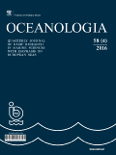
OCEANOLOGIA
Transforming Ocean Knowledge into ActionOCEANOLOGIA, a distinguished academic journal published by the Polish Academy of Sciences, Institute of Oceanology, serves as a pivotal platform for researchers and professionals in the fields of Aquatic Science, Oceanography, and Ocean Engineering. Established in 1973 and transitioning to Open Access in 2011, this peer-reviewed journal promotes the dissemination of high-quality research across its diverse scope of ocean-related topics, aligning with its commitment to advancing marine science. With a notable impact factor underscored by its positioning in the Q1 and Q2 quartiles of recognized categories, OCEANOLOGIA stands out with impressive Scopus Rankings, including 49/247 in Aquatic Science and 24/105 in Ocean Engineering, reflecting its significance in the global research landscape. The journal's dedication to publishing cutting-edge studies ensures that it continues to influence both academic discourse and practical applications in ocean-related fields, making it an essential resource for students, researchers, and professionals aiming to contribute to the advancement of oceanic studies.

Environmental Earth Sciences
Exploring the intersection of Earth and environment.Environmental Earth Sciences is a prestigious journal published by Springer, dedicated to advancing knowledge in the multifaceted fields of Earth Sciences, including Earth-Surface Processes, Environmental Chemistry, Geology, and Soil Science. With an ISSN of 1866-6280 and an E-ISSN of 1866-6299, this journal occupies a notable position in the academic landscape, consistently ranked in the Q2 category across multiple disciplines in 2023. It supports open access to foster wider dissemination of impactful research, enhancing visibility and accessibility for authors and readers alike. The journal's ongoing commitment to publishing innovative studies and reviews makes it an essential resource for researchers, professionals, and students alike. With a strong focus on addressing contemporary environmental challenges, Environmental Earth Sciences invites contributions that are both original and interdisciplinary, making a significant impact in understanding Earth dynamics and sustainability.

BASIN RESEARCH
Bridging Theory and Application in Basin StudiesBasin Research, published by Wiley, is a leading journal in the field of Geology, with a distinguished reputation affirmed by its Q1 ranking in the 2023 category of Earth and Planetary Sciences. Since its inception in 1988, the journal has been at the forefront of fundamental and applied research surrounding sedimentary basins, delving into their evolution, architecture, and dynamics. With an impressive Scopus rank of #36 out of 321, placing it in the 88th percentile, Basin Research serves as a critical platform for researchers, professionals, and students engaged in advancing our understanding of geological processes and their implications for natural resources and environmental policies. The journal is accessible to a global audience and emphasizes high-quality, peer-reviewed articles that cover a diverse array of topics from basin analysis to sedimentology and beyond. For those interested in deepening their insights into this vital area of study, Basin Research stands as an invaluable resource in the academic landscape.

Geografia Fisica e Dinamica Quaternaria
Advancing Knowledge of Earth-Surface ProcessesGeografia Fisica e Dinamica Quaternaria is a leading Italian journal dedicated to the exploration and understanding of Earth-surface processes through the lens of Quaternary geology. Published by the COMITATO GLACIOLOGICO ITALIANO, this journal has been a key player in the dissemination of pivotal research since 1978, significantly contributing to the field of Earth and Planetary Sciences. With an ISSN of 0391-9838 and E-ISSN 1724-4781, it serves as an essential platform for scholars and practitioners, offering insights into the dynamics of climate change, glacial processes, and landscape evolution. Although categorized in the Q3 quartile for Earth-surface processes in 2023, the journal continues to foster a robust academic community, emphasizing the significance of interdisciplinary approaches in understanding our planet's past and present. Access options may vary, presenting potential considerations for readers. By bridging theoretical research with practical implications, Geografia Fisica e Dinamica Quaternaria remains an indispensable resource for advancing knowledge and promoting dialogue within the scientific community.
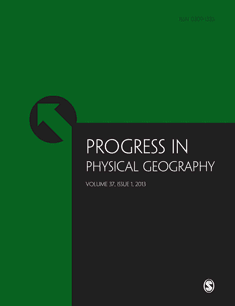
Progress in Physical Geography-Earth and Environment
Charting new territories in Earth and Planetary Sciences.Progress in Physical Geography-Earth and Environment is a premier academic journal published by SAGE Publications Ltd, renowned for its contributions to the fields of Earth and Planetary Sciences and Geography. With a distinguished history spanning from 1977 to 2024, this journal maintains a robust Q1 classification in both Earth and Planetary Sciences and Geography, Planning and Development, reflecting its high impact and rigorous scholarly standards. As evidenced by its Scopus rankings, it stands at the forefront of research, positioned in the 89th percentile among leading journals. Progress in Physical Geography aims to facilitate the exchange of innovative research, insights, and methodologies, making it an essential resource for researchers, professionals, and students dedicated to understanding and shaping the natural environment. While currently not designated as an Open Access journal, the wide accessibility of its content, combined with its significant impact factor, underscores its importance within the academic community seeking to advance knowledge and application in geography and environmental sciences.
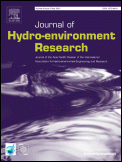
Journal of Hydro-environment Research
Bridging human activities and water resources through research.The Journal of Hydro-environment Research, published by Elsevier, serves as a leading platform for advancing knowledge in the fields of civil and structural engineering, environmental chemistry, and water science. With a robust impact factor reflecting its Q2 category ranking across various disciplines—including Environmental Engineering and Management, Monitoring, Policy and Law—it emphasizes high-quality research that addresses pressing environmental challenges. Embracing a global perspective, the journal explores interdisciplinary approaches to water and environmental management, thus empowering researchers and professionals to innovate and implement effective solutions. Since its inception in 2007, the journal has continually evolved, with its scope expanding into emerging areas pertinent to water science and technology. The journal is indexed in esteemed databases, ensuring wide dissemination and accessibility of published works, although it does not currently operate on an open access model. Addressing the intricate interplay between human activities and water resources, the Journal of Hydro-environment Research is quintessential for those dedicated to fostering sustainable practices and enhancing our understanding of hydro-environmental systems.

GEOMORPHOLOGY
Innovating the Study of Earth-Surface Dynamics.GEOMORPHOLOGY, published by Elsevier, is a leading journal that focuses on the study of landforms, along with the processes that shape them. Established in 1984, the journal has evolved to become an essential resource for researchers in the field of Earth-Surface Processes, currently holding a prestigious Q1 quartile ranking and occupying the 17th position out of 179 journals in Scopus, placing it within the top 10% of publications in this domain. This impact underscores its significance in advancing understanding within geosciences, providing a platform for both foundational and innovative research. GEOMORPHOLOGY publishes a diverse array of articles, from empirical studies to theoretical advancements, ensuring accessibility for a broad audience of students, professionals, and academics alike. With its commitment to high-quality research, this journal serves as a critical reference point for ongoing developments and discoveries in geomorphology.